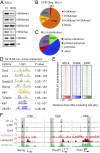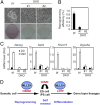Enhancer priming by H3K4 methyltransferase MLL4 controls cell fate transition
- PMID: 27698142
- PMCID: PMC5081576
- DOI: 10.1073/pnas.1606857113
Enhancer priming by H3K4 methyltransferase MLL4 controls cell fate transition
Abstract
Transcriptional enhancers control cell-type-specific gene expression. Primed enhancers are marked by histone H3 lysine 4 (H3K4) mono/di-methylation (H3K4me1/2). Active enhancers are further marked by H3K27 acetylation (H3K27ac). Mixed-lineage leukemia 4 (MLL4/KMT2D) is a major enhancer H3K4me1/2 methyltransferase with functional redundancy with MLL3 (KMT2C). However, its role in cell fate maintenance and transition is poorly understood. Here, we show in mouse embryonic stem cells (ESCs) that MLL4 associates with, but is surprisingly dispensable for the maintenance of, active enhancers of cell-identity genes. As a result, MLL4 is dispensable for cell-identity gene expression and self-renewal in ESCs. In contrast, MLL4 is required for enhancer-binding of H3K27 acetyltransferase p300, enhancer activation, and induction of cell-identity genes during ESC differentiation. MLL4 protein, rather than MLL4-mediated H3K4 methylation, controls p300 recruitment to enhancers. We also show that, in somatic cells, MLL4 is dispensable for maintaining cell identity but essential for reprogramming into induced pluripotent stem cells. These results indicate that, although enhancer priming by MLL4 is dispensable for cell-identity maintenance, it controls cell fate transition by orchestrating p300-mediated enhancer activation.
Keywords: H3K4 methyltransferase; MLL4/KMT2D; cell fate transition; enhancer; p300.
Conflict of interest statement
The authors declare no conflict of interest.
Figures





References
-
- Keller G. Embryonic stem cell differentiation: Emergence of a new era in biology and medicine. Genes Dev. 2005;19(10):1129–1155. - PubMed
Publication types
MeSH terms
Substances
LinkOut - more resources
Full Text Sources
Other Literature Sources
Molecular Biology Databases
Research Materials
Miscellaneous

